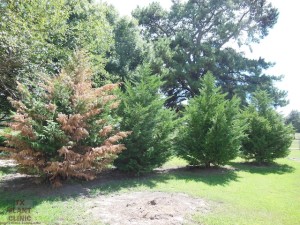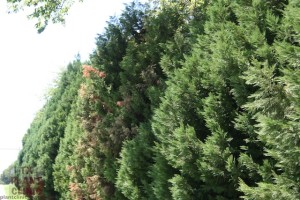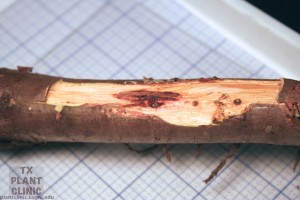Mid-September 2015

One dying cedar in a row of cedars
The last four weeks, I got at least 3 questions regarding why junipers or pines are dying. Often the story is that there is one or two plants that are affected in amongst a bunch of trees. Symptoms usually begins with several branches exhibiting die-back, gradually gets worse. Some narrative states that the plant appear to die quickly one the dieback started. SO what is going on….
Some narrative states that the plant appear to die quickly one the dieback started. SO what is going on….

Dying branches on Leyland cypress (found Seiridium canker)
I remember back in 2007… The scenario = 2005/2006 hard drought years and 2007 wet spring, mild temperature thru to August. Trees (juniper, cedars, leyland cypress, pines) look great early on, but when the rain “finally” stopped, it got dry again very quickly. And trees appear to start exhibiting decline symptoms. In some cases, we could find cankers, usually at the base or near to the base of affected branches and these turn out to be caused by the fungus Seiridium sp. which could result in branch dieback. In other cases, with pines and cedar especially, we see a lot of “leakage” or weeping with something that looks like sap build-up. Sometimes, we find Fusarium sp or insect borer or nothing…

Weeping on cedar due to stress.
So this got me thinking: why…in a stand of trees, only a few appear to be affected? what is causing this ailment?
The best answer my mind could come up is stress is the primary effector. With the environment swing from a sparse or low resource year (drought) to one that is plenty (lots of water) to suddenly no water again is stressful to the plant. I know I get out of whack (I blame blood sugar! and some TPDDL staffs call me crabby) when I skip a day’s worth of meals and then gorge out at breakfast the next morning, and then go without the rest of the day. I also believe that these plants are also susceptible to damage cause by freeze damage or even heat damage contributing to wounds that pathogen could gain a foothold or be enticing to insect pests.
So what to do and how to “try” to figure out what is going on if you have that situation where 1 or 2 trees in your windbreak row dies?
- Examine the affected branches. See if you find any cankers or insect borer damage (gummosis is a clue).
- If problem is just beginning, ie. 1-2 branches affected. Do #1 and then prune out affected branches. If plants are valuable, can use a broad spectrum fungicide to protect tree (if see canker and suspect fungal pathogen). If insect borer, you might be able to find some product that can be used on landscape trees too. You know, you can always call your local Texas A&M AgriLife Extension county office for help.
- IF tree is dead (all brown and brittle), plan on removing the plant….at some point. Start thinking about how to fill in the space with another plant or to leave them naturally open space.

Subtle looking canker on a Leyland Cypress

Dead plant tissue, canker damage, is visible when bark is peeled away,
It is not easy to see trees dying and one does NOT always find a pathogen or insect to blame for the demise of the tree. Sometimes it is nature and it happens. So the message is to always nurture your trees, in the good times and bad times, and do NOT overdo it! -KO



